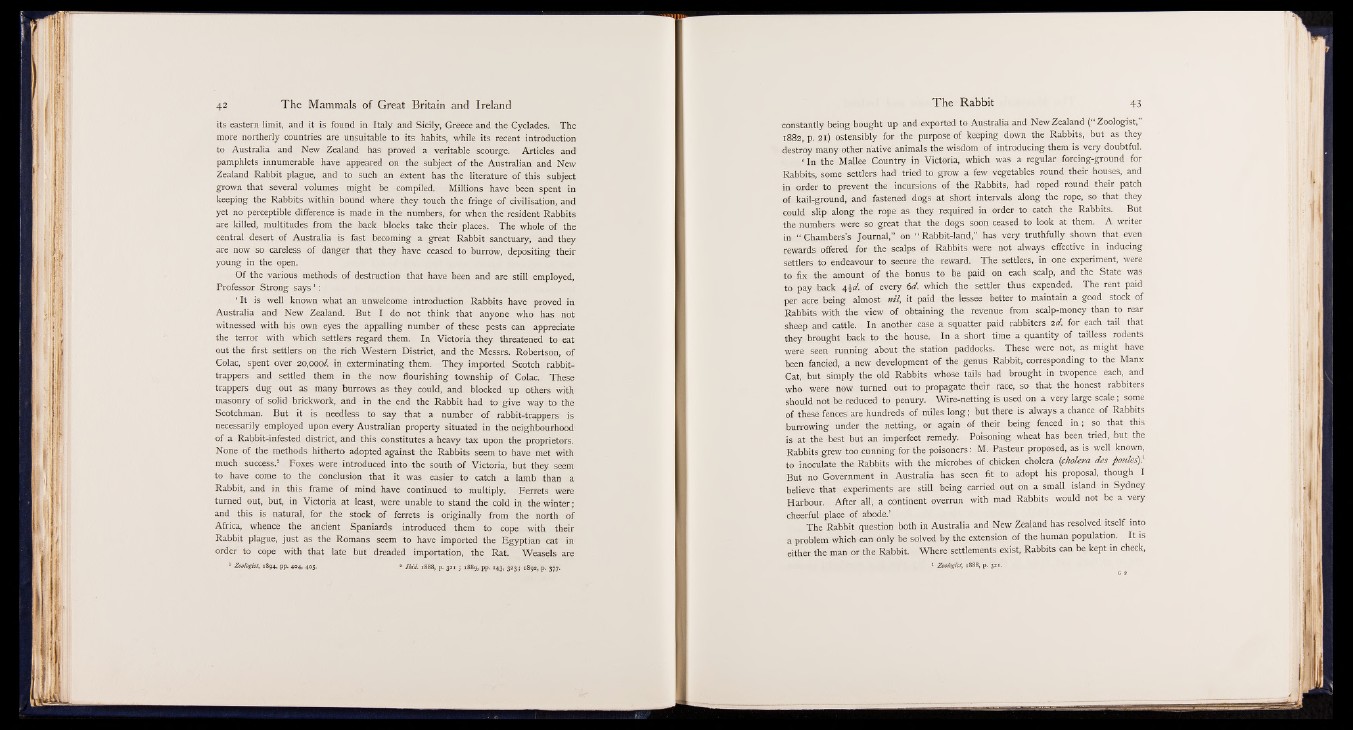
its eastern limit, and it is found in Italy and Sicily, Greece and the Cyclades. The
more northerly countries are unsuitable to its habits, while its recent introduction
to Australia and New Zealand has proved a veritable scourge. Articles and
pamphlets innumerable have appeared on the subject of the Australian and New
Zealand Rabbit plague, and to such an extent has the literature of this subject
grown that several volumes might be compiled. Millions have been spent in
keeping the Rabbits within bound where they touch the fringe of civilisation, and
yet no perceptible difference is made in the numbers, for when the resident Rabbits
are killed, multitudes from the back blocks take their places. The whole of the
central desert of Australia is fast becoming a great Rabbit sanctuary, and they
are now so careless of danger that they have ceased to burrow, depositing their
young in the open.
Of the various methods of destruction that have been and are still employed,
Professor Strong says1 :
‘ It is well known what an unwelcome introduction Rabbits have proved in
Australia and New Zealand. But I do not think that anyone who has not
witnessed with his own eyes the appalling number of these pests can appreciate
the terror with which settlers regard them. In Victoria they threatened to eat
out the first settlers on the rich Western District, and the Messrs. Robertson, of
Colac, spent over 20,000/. in exterminating them. They imported Scotch rabbit-
trappers and settled them in the now flourishing township of Colac. These
trappers dug out as many burrows as they could, and blocked up others with
masonry of solid brickwork, and in the end the Rabbit had to give way to the
Scotchman. But it is needless to say that a number of rabbit-trappers is
necessarily employed upon every Australian property situated in the neighbourhood
of a Rabbit-infested district, and this constitutes a heavy tax upon the proprietors.
None of the methods hitherto adopted against the Rabbits seem to have met with
much success.2 Foxes were introduced into the south of Victoria, but they seem
to have come to the conclusion that it was easier to catch a lamb than a
Rabbit, and in this frame of mind have continued to multiply. Ferrets were
turned out, but, in Victoria at least, were unable to stand the cold in the winter;
and this is natural, for the stock of ferrets is originally from the north of
Africa, whence the ancient Spaniards introduced them to cope with their
Rabbit plague, just as the Romans seem to have imported the Egyptian cat in
order to cope with that late but dreaded importation, the Rat. Weasels are
1 Zoologist, 1894, pp. 404, 405. * Ibid. 1888, p. 321 ; 1889, pp. 143, 323; 1892, p. 377.
constantly being bought up and exported to Australia and New Zealand (“ Zoologist,
1882, p. 21) ostensibly for the purpose of keeping down the Rabbits, but as they
destroy many other native animals the wisdom of introducing them is very doubtful.
‘ In the Mallee Country in Victoria, which was a regular forcing-ground for
Rabbits, some settlers had tried to grow a few vegetables round their houses, and
in order to prevent the incursions of the Rabbits, had roped round their patch
of kail-ground, and fastened dogs at short intervals along the rope, so that they
could slip along the rope as they required in order to catch the Rabbits. But
the numbers were son great that the dogs soon ceased to look at them. A writer
in “ Chambers’s Journal,” on “ Rabbit-land," has very truthfully shown that even
rewards offered for the scalps of Rabbits were not always effective in inducing
settlers to endeavour to secure the reward. The settlers, in one experiment, were
to fix the amount of the bonus to be paid on each scalp, and the State was
to pay back e,\d. of every 6d. which the settler thus expended. The rent paid
•per acre being almost n il, it paid the lessee better to maintain a good stock of
Rabbits with the view of obtaining the revenue from scalp-money than to rear
sheep and cattle. In another case a squatter paid rabbiters id . for each tail that
they brought back to the house. In a short time a quantity of tailless rodents
were seen. :running about the station paddocks. These were not, as might have
been fancied, a new development of the genus Rabbit, corresponding to the Manx
Cat, but simply the old Rabbits : whose tails had brought in twopence each, and
who were now turned out to propagate their race, so that the honest rabbiters
should not be reduced to penury. Wire-netting is used on a very large scale ; some
of these fences.are hundreds miles long; but there is always a chance .of Rabbits
burrowing under the netting, or again of their being fenced in; so that this
is at the best but an imperfect remedy. Poisoning wheat has been tried, but the
Rabbits grew too cunning for the poisoners: M. Pasteur proposed, as is . well known,
to inoculate the Rabbits with the microbes of chicken cholera {cholera des poules)}
But no Government in Australia has seen fit .to adopt his proposal, though I
believe that experiments are still being carried out on a small island in Sydney
Harbour. After all, a continent overrun with mad Rabbits would not be a very
cheerful place of abode.’
The Rabbit question both in Australia and New Zealand has resolved itself into
a problem which can only be Solved by the extension of the human population. It is
either the man or the Rabbit. Where settlements exist, Rabbits can be kept in check,
Zoologist, 1888, p. 321.